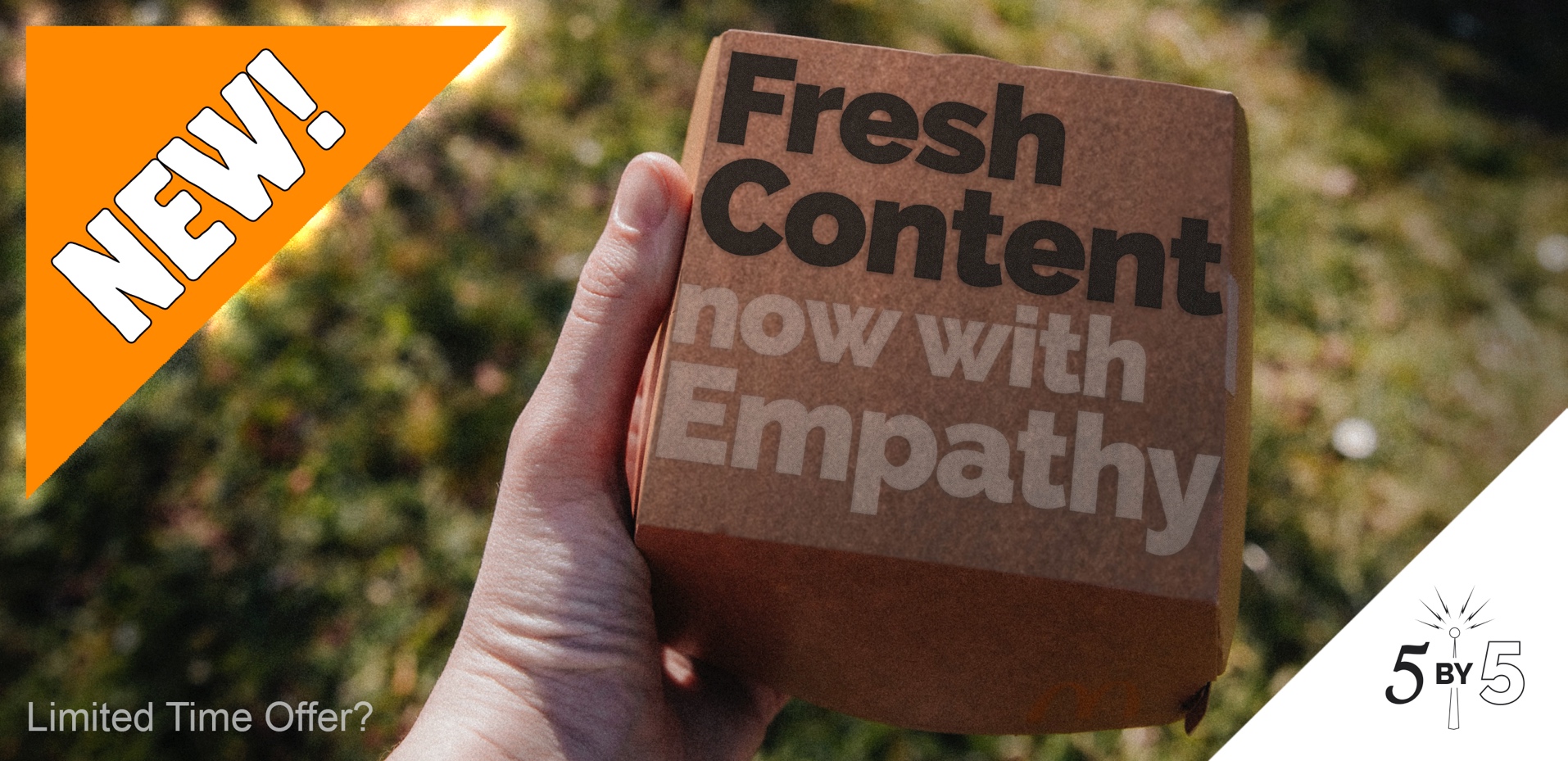
COVID-19 caused thousands of companies to pause their social media engagement and give serious thought to how to behave in the midst of a global crisis. And it got a lot of marketers talking about how to create content that leads with empathy and acknowledges our shared challenges and fears. There was a global call for more personal, more human, content. To wit: Between February 1 and April 30, total share of volume for the keyword “empathy” grew 91.4% on Twitter.

Source: alpha | BRAVO Sprout Social dashboard
The ubiquity of content has created so much clutter we’ve become immune. On WordPress alone, 70 million posts are published every month. Still, 78% of marketers plan to increase their content budget for 2021, according to LinkedIn. A recent Contently article suggests that content will get better as a result. I’m not so sure I agree.
As consumers, we scroll too fast to read, marking the occasional headline with a like or share without ever having read the article. As content creators, we churn it out, fast food style like value meals.
I’ll take a Number 4 with a landing page and a Sponsored Content post, please.
This content quick-serve model we’ve been working under serves no one. Relevance we’ve got in spades, but where is the emotional connection? The numbers speak volumes: where else are click thru rates of less than 1% acceptable? Brands will continue to struggle to create content that connects with their audience unless they can learn how to write in a way that resonates with readers.
Great content builds trust that lasts.
What’s gotten lost is our desire to tell a story worth reading. We’re writing for likes, clicks, and engagements. And yes, at the end of the day the objective of brand content is to build brand awareness, and/or leads. But here’s the thing: We have to do something with that awareness. We need a plan of action for those leads. The most valuable commodity a brand has at its disposal is trust, but that trust must be earned, and racking up likes won’t do it.
What will? Connections.
Before I became a content writer, I spent my time writing personal essays and articles on spec for various magazines and anthologies. I owe my first publishing credit to award-winning writer and essayist, Linda O’Connell, who also happens to be a friend and mentor from the St. Louis Writer’s Guild. She read an early draft of one piece and told me to trigger readers’ memories with flashbacks. “Let us experience the emotion with you.” she advised. I quickly learned that if I wanted my stories to resonate with readers, I needed to write from a place of shared experiences.
By 2014, I was a content marketer by day, and an author in the evenings. The techniques I was using at night found their way subconsciously into my day job. I didn’t know it at the time, but that was the key to my success as a content writer. Eventually, I stopped writing personal essays (it didn’t pay the bills like content writing did). At some point along the way, though, I lost my ability to tell a moving story, to reach readers the way I had in those essays. My content marketing brain took over, and I focused on driving likes and shares and clicks, rather than emotion. Sound familiar?
Remember that your audience isn’t one dimensional. They’re human beings with full lives. If you’re a B2B software company that targets IT pros, keep in mind that those IT pros aren’t just employees. They’re partners, parents, homeowners, sci-fi movie fanatics, fidgeters, gamers, and so on. There’s lots to work with there.
Creative writers, like my friend Linda, use different techniques than their content writer counterparts, but I think it’s high time we start to use them in our branded content. That’s why I asked 10 creative writers to share their best advice for brand content writers on how to craft stories that connect with readers.
A call for empathy
In her book ‘The Moment of Lift’, Melinda Gates talks a lot about empathy. Empathy helps end bias. It helps us understand other’s perspectives, and when we understand we’re able to connect more deeply. Empathy is what drives connections. The COVID-19 wake-up call is a call to brands to be more empathetic. But much of the content brands are publishing right now doesn’t show it. If we are to truly be more empathetic, more personal, more human, we need to write like it. The first step is to use inclusive language. This blog post from ROC Group offers some valuable advice.
“Creating content that connects with your readers’ hopes and dreams and business needs,” says acclaimed social media consultant Mark Schaefer, “is the way to build long-term connections that resonate.” [Read Mark’s full post on why ‘resonance’ is the future of SEO.] Mark is known for having a strong personal brand, even admitting that it’s what saved his business during the past several months. “Create insights by being curious and connecting the dots in new ways,” Schaefer adds. “Call on your experience, education, and heritage to look at something from a different angle.” [Read Mark’s full post on 4 ways to jumpstart your content marketing].
Content writer Kelley Hartnett is known for her unique ability to capture a comfortable, friendly voice. Her advice? “Lean into empathy. Whatever you’re writing should be helping someone solve a problem, “she says. “When you can imagine what it must *feel like* to have that problem, you’ll write more human/empathetic copy that resonates with readers.
Freelance journalist and Humanities teacher, Stephen Fairbanks, suggests offering readers analogies from their own lives, using language they’re most familiar with to emphasize connection and commonality.
Freelancer writer Rebecca Rutherford connects with her audience by appealing to both sides of the brain, incorporating creative, empathetic stories and examples for right-brained readers, and reliable sources and data for left-brained readers. “A good balance of both helps to build trust,” she says.
Writer Shira Miller, who’s also a TEDx Speaker and Executive Coach, uses humor and personal stories to connect with readers. Pacing is another trick creative writers use to keep audiences engaged.
“Good pacing can speak to the subconscious mind,” says freelance creative writer T’Mara Goodsell. “For example, long and rhythmic sentences can feel hypnotic, or they can mimic a racing heart. And short sentences can feel impactful, like a punch.”
Feature writer Mallory Mast uses the same technique. “Incorporate sensory descriptions in a rhythm that matches the scene,” she suggests. “Think about the hierarchy of details and balance the prose and flow in a way that matches the emotion you’re trying to convey.”
One of my favorite authors, Chris Cleave, suggests looking for the story behind the story. Let’s say you’re writing content about a hybrid cloud solution for which you clearly have no amorous feelings. That’s okay, most people don’t. What you might appreciate, though, is the fact that the solution gives you more free time. And you might really like that you can use that time to either focus on your customers or make it to your daughter’s first dance recital on time. And that is the key. These solutions give you your life back. They give you the ability to create cherished memories. They give you the gift of time. That’s the real story behind the story.
Speaking of stories, one of my creative writing professors, Steve Lattimore, explained the perfect narrative arc this way: “Put your protagonist up a tree, throw rocks at her, then get her down.” If we want to give our audiences a solution they can believe in, we need to show them that we understand their challenges – show them stuck up in the tree. It always gets worse before it gets better – that’s where we “throw rocks” at them. Make the situation more difficult, then show them how to get down.
If you feel a bit like the protagonist in a crazy story right now, you’re not alone. The majority of us have had a few rocks hurled our way over the past several months. If it’s true that economic downturns lead to dramatic realizations, though, then this pandemic is a catalyst for change, at least in the form of a return to content that captures readers’ challenges and lets them see themselves in the stories we tell. Say ‘goodbye’ to quick-serve content. If you want to start conversations and build stronger relationships, tell stories your audience will remember long after they’ve read the last line.
If you want to create stronger content that connects with your audience, a content audit is a great place to start.


